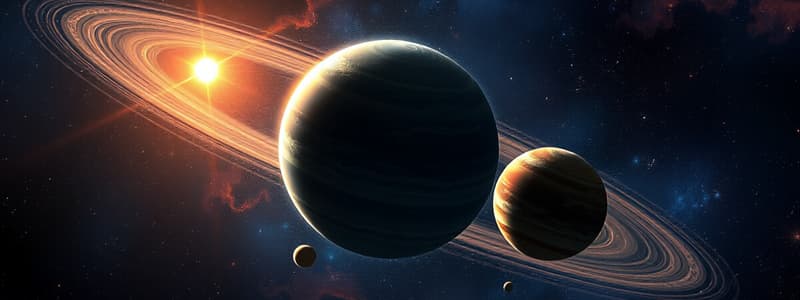Podcast
Questions and Answers
What is the official definition of a planet according to the International Astronomical Union (IAU), and why does this definition exclude Pluto from having the status of a planet?
What is the official definition of a planet according to the International Astronomical Union (IAU), and why does this definition exclude Pluto from having the status of a planet?
A planet is a celestial body that is in orbit around the sun, has a sufficient mass to maintain a nearly round shape, and has 'cleared the neighborhood' around its orbit. Pluto is still colliding and changing shape.
What discovery triggered the change in definition of planets that now excludes Pluto?
What discovery triggered the change in definition of planets that now excludes Pluto?
The actual size of Pluto was found to be much smaller than expected, and similar-sized objects were discovered, leading to the need for reclassification.
When and where did the change in definition of planets that now excludes Pluto occur?
When and where did the change in definition of planets that now excludes Pluto occur?
In August 2006 at the IAU conference in Munich.
What is the counterargument to the idea that planets should be defined only by their intrinsic properties?
What is the counterargument to the idea that planets should be defined only by their intrinsic properties?
How did the maria on the Moon form, and why do their appearances differ from that of the lunar highlands?
How did the maria on the Moon form, and why do their appearances differ from that of the lunar highlands?
Why does the surface of the Moon maintain a record of the era of early bombardment while Earth's surface does not?
Why does the surface of the Moon maintain a record of the era of early bombardment while Earth's surface does not?
How does crater density and solidification ages of Moon rocks suggest that the cratering rate on the Moon has not been constant over time?
How does crater density and solidification ages of Moon rocks suggest that the cratering rate on the Moon has not been constant over time?
Why are craters on Mercury typically larger than craters found on the Earth's Moon?
Why are craters on Mercury typically larger than craters found on the Earth's Moon?
What recent evidence discovered in Antarctica implies that life may have once existed on Mars?
What recent evidence discovered in Antarctica implies that life may have once existed on Mars?
What recent evidence found on Mars proves that there was once liquid water on its surface?
What recent evidence found on Mars proves that there was once liquid water on its surface?
Name and explain two pieces of evidence that Titan has ongoing volcanism on its surface.
Name and explain two pieces of evidence that Titan has ongoing volcanism on its surface.
Explain the major source of Io's internal heating.
Explain the major source of Io's internal heating.
Flashcards are hidden until you start studying
Study Notes
Definition of a Planet
- A planet, as defined by the International Astronomical Union (IAU), must orbit the sun, have sufficient mass for a nearly round shape, and have cleared its orbital neighborhood.
- Pluto is classified as a dwarf planet because it does not clear its orbit and is still colliding and changing shape.
Discovery Leading to Pluto's Exclusion
- The realization of Pluto's smaller actual size, determined through observations of its moon, prompted a reevaluation of its planetary status.
- Discovery of similar-sized bodies in the Kuiper Belt necessitated redefining planets or classifying these new objects as planets.
Change of Definition Details
- In August 2006, during the IAU conference in Munich, Pluto was reclassified as a dwarf planet after 76 years as a planet.
- Pluto was discovered in 1930 by Clyde Tombaugh.
Classification of Moons and Planets
- Some astronomers advocate defining planets solely by intrinsic features like size and shape.
- Counterarguments emphasize that orbit-related classification helps maintain distinctions between moons and planets; many moons are large yet categorized based on their orbits.
Formation of Lunar Maria
- The lunar maria were formed from ancient volcanic eruptions, filling impact basins with lava.
- Maria have a different appearance than lunar highlands due to their iron-rich compositions making them less reflective.
Moon vs. Earth Geological Processes
- The Moon's surface retains a record of early solar system bombardment due to the absence of geological processes that would erase such records, unlike Earth's surface.
Crater Density and Lunar History
- Apollo lunar sample analysis indicates a non-constant cratering rate and supports the notion of early heavy bombardment.
- Isotopic dating suggests most impact melts occurred during a narrow time frame, possibly influenced by gas giants scattering objects into eccentric orbits.
Mercury's Crater Size
- Craters on Mercury are typically larger than those on the Moon due to its closer proximity to the Sun, resulting in faster orbits and higher impact velocities.
Evidence of Life on Mars
- A meteorite discovered in Antarctica may contain fossilized microbial life from Mars, as suggested by microscopic features and chemical compositions.
Liquid Water Discovery on Mars
- Evidence from Mars rovers indicates water is trapped in Martian soil, especially at the poles, with geological features suggesting water once flowed on the surface.
Evidence of Ongoing Volcanism on Titan
- Titan displays characteristics of ongoing volcanism—frozen volcanic flows visible in near-infrared light and a notable absence of impact craters, implying resurfacing events.
Io's Internal Heating
- Io's internal heating is primarily due to tidal flexing caused by its eccentric orbit, which leads to varying speeds as it orbits Jupiter, causing significant gravitational heating.
Studying That Suits You
Use AI to generate personalized quizzes and flashcards to suit your learning preferences.




